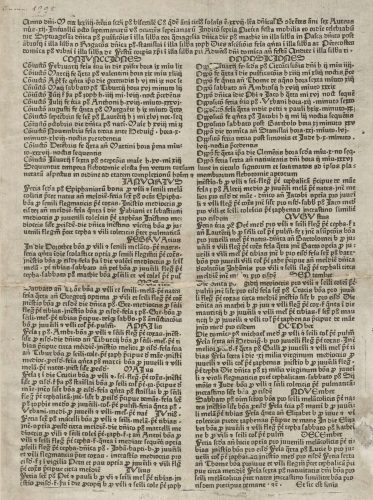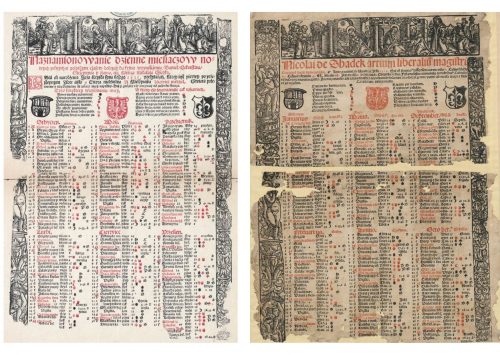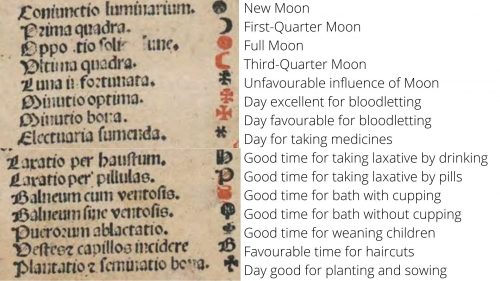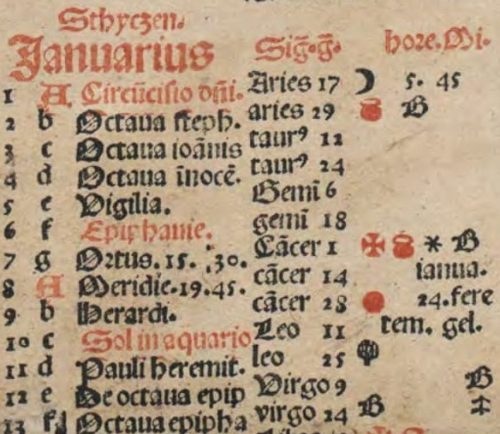To interpret the earliest known calendar printed in Cracow one had to be well versed in Latin. The Almanach Cracoviense ad annum 1474 (fig. 1), which is considered to be the first print produced in Cracow, is a single sheet of paper (26 x 37 cm) with text printed single-sided in two columns with black ink. It was produced by an itinerant Bavarian printer, Kasper Straube, who established his printing shop and worked in Cracow between 1473 and 1477.

Apart from the text layout, nothing else eased the task of the reader, who had to retrieve all necessary information from a plain text. It was dense with information such as dates of feasts given according to the liturgical calendar, conjunctions and eclipses of the Moon and Sun as well as the time most suitable for bloodletting, which depended on age, type of personality and the particular illness.
Kasper Straube did not use red ink in any of his Cracow prints, but German printers embellished their calendars and organized the information in a more intuitive way with the use of red already in the 1470s. It is impossible to establish a fixed date when colour was introduced to Cracow broadside calendars. There is a black-and-white photograph of a bi-colour Polish-language calendar from ca. 1519/1520, but the current location of the original remains unknown since the 1980s (Wydra 2010). Perhaps attempts to introduce double-ink printing to the production of broadside calendars in Cracow were made before the 1520s, but the fact that single sheet calendars were the most used and easily disposable prints, made it difficult to find earlier examples.
Waste papers preserved between sixteenth-century bindings safeguarded the fragments of Latin- and Polish-language calendars by Nicolaus of Szadek (fig. 2-3). Both calendars, Ephemerides. Anno 1525 and Naznamionowanie dzienne miesiącow nowych pełnych lata 1525, were printed with the use of black and red ink by Hieronimus Vietor in 1524.

If the reader’s eye followed the red colour in the Polish-language calendar, it first caught the headline explaining that the calendar offers calculations of the days of each month that are convenient for bloodletting, cupping, taking medicines, planting and sowing. The heading indicates practical use of the calendar in medical treatments and common agricultural activities and only briefly mentions the name of the author – master Nicolaus of Szadek – who must have been well known among Polish readers. His name received a more prominent place in the Latin version of the calendar. Whereas the headline of the calendar begins with the name of the author and builds his authority, the one-word title of the print, Ephemerides (from Greek “ἐφημερίς”, denoting diary or journal), is put at the end of the heading. In the Latin calendar, addressed to the international audience for which numerous other prominent scholars issued their calendars, Nicolaus is introduced as a magister of liberal arts and alumnus of the University of Cracow. In fact, Nicolaus of Szadek became a professor of astrology in 1515 and eight years later was appointed as the dean of the faculty of philosophy. The readers’ attention is directed to the author’s link to the University, which was renowned for astrological studies from the mid-fifteenth century. On the bequest of Johannes Stobner (1405) a new chair of astronomy was established and it became an obligation of its professor to prepare an annual almanac regarding the movements of the heavenly bodies at the meridian of Cracow (Knoll 2016: 136). After the reform of the Faculty of Arts (1449), the chair funded by Stobner was responsible for teaching arithmetic, music, planetary theory, the Alphonsine tables (i.e. astronomical data, compiled at the court of Alfonso X of Castille for computing the position of the Sun, Moon and planets) as well as for predicting eclipses and updating the almanacs (ibid.). Around 1450 Martinus Rex de Premislia (Polish: Marcin Król), established a new chair in practical astronomy, concentrated mainly on astrology, which along with the previous so-called Stobner chair contributed to elevation of Cracow University to a major centre of astronomical and astrological research in Europe (Knoll: 143). The production of astrological texts also grew significantly. The University’s Statutes of 1476 inform that the professor of the chair of astronomy is expected to write a prediction for the coming year in three different versions: a detailed one for professional use, another prognosticon for representatives of academics constituting the Collegium Maius (this calendar was advised to be delivered to the councilors of Cracow), and last but not least, a prognosis including astrological information addressed to the general audience. By 1520s the tradition of issuing handwritten and later also printed almanacs was well established in Cracow. In fact, the quickly developing print market in Cracow became one of the main hubs of astrological prints production, next to Leipzig and Vienna (Chojecka 1963: 320).
Returning to Nicolaus of Szadek’s calendar, its second red component is the Polish coat of arms. It indicated a quasi-official character of the print and drew the reader’s attention to the legend for 15 (in Latin version, fig. 4) or 14 (in Polish one) highly conventional calendrical symbols, used (with some variations) already in the fifteenth-century calendars (Kusukawa 2011: 99). These small marks, printed in black or red, were used in calendars to inform the reader about the phases of the moon, convenient and excellent times for bloodletting, favorable times for cupping therapy and indications when one should sow, plant or wean children.


[expand more_text=”Show more” less_text=”Show less” height=”120″ hide_less=”no” text_color=”#333333″ link_color=”#B26B70″ link_style=”default” link_align=”left”]Quoted literature:
Chojecka, Ewa. 1963. „Krakowska grafika kalendarzowa XVI w.” [Cracow calendar graphic arts in the sixteenth century]. Studia renesansowe 3: 312–482.
Knoll, Paul W. 2016. “A Pearl of Powerful Learning”: the University of Cracow in the Fifteenth Century. Leiden; Boston: Brill.
Kusukawa, Sachiko. 2011. “Andreas Nolthius’s Almanach for 1575.” Journal for the History of Astronomy 42/1: 91–110.
Wydra, Wiesław, ed. 2010. [Mikołaj z Szadka, Naznamionowanie dzienne miesiącow nowych pełnych lata 1520?. Kraków, Hieronim Wietor, 1519/1520]. Poznań: Wydawnictwo Poznańskie Studia Polonistyczne. http://www.wbc.poznan.pl/Content/328923/PDF/index.pdf.
[/expand]